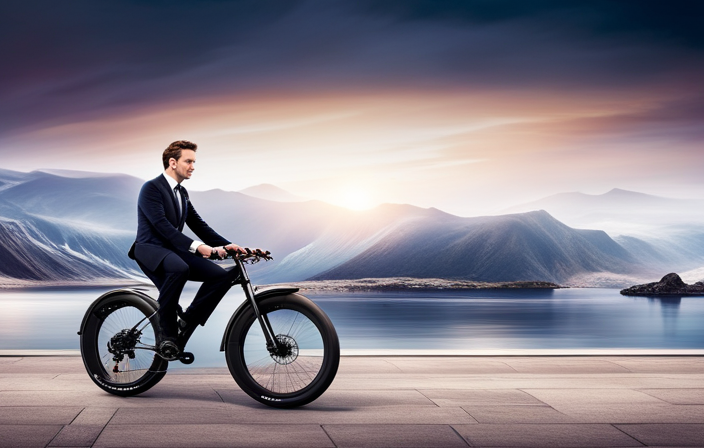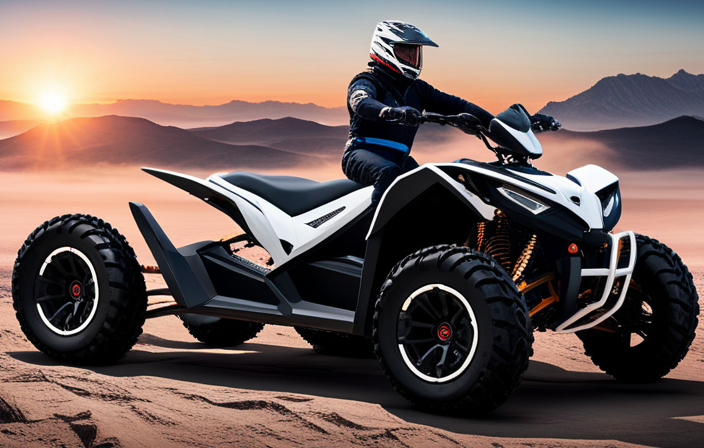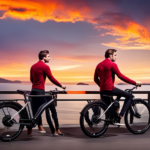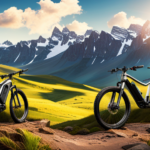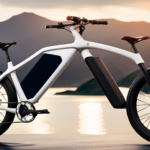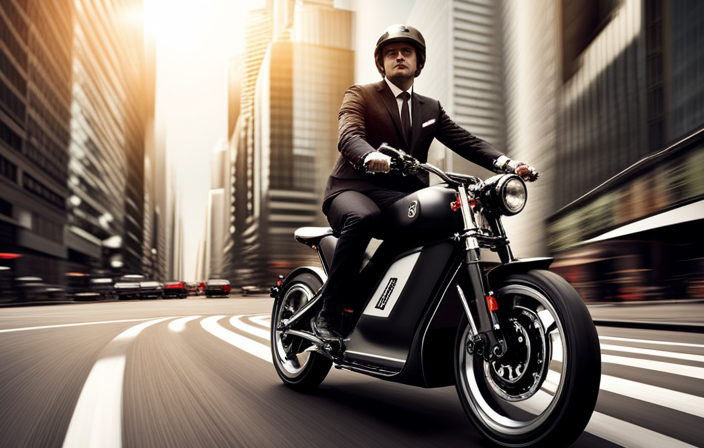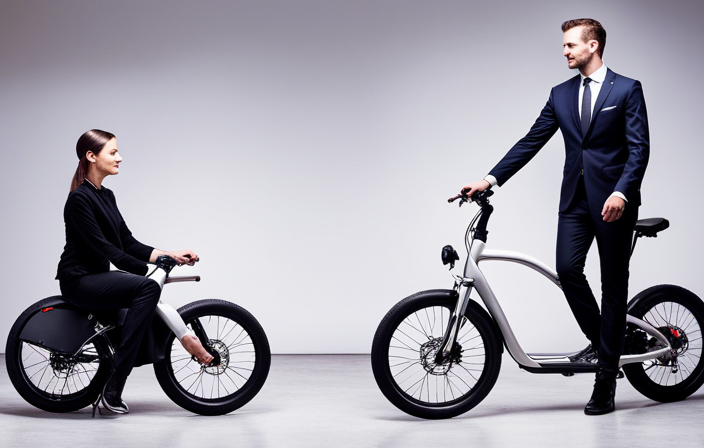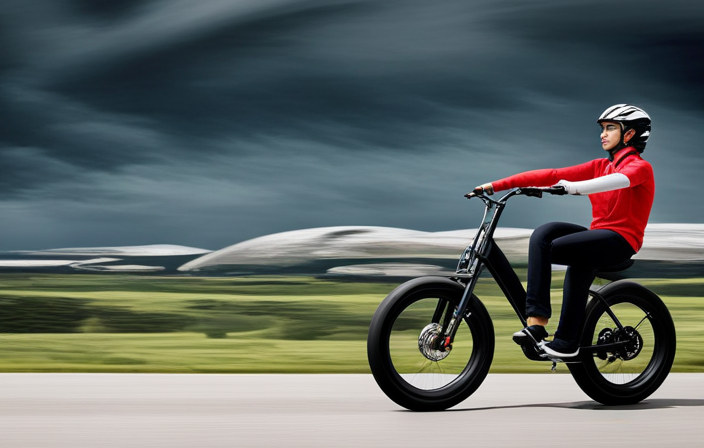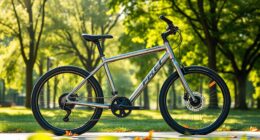Are you searching for the ideal electric bike motor to take your cycling experience to the next level? Search no more!
You might think that finding the best option is a breeze, but oh, how wrong you are. With so many types, power levels, and compatibility factors to consider, it’s enough to make your head spin.
But fear not! In this article, we’ll guide you through the technical intricacies, analyze the power and performance, and provide insightful user reviews to help you make an informed decision.
So, let’s dive into the world of electric bike motors and find the one that will truly electrify your ride.
Key Takeaways
- The type of electric bike motor, such as hub motors or mid-drive motors, determines the power delivery and efficiency.
- Power and performance are determined by the wattage and torque of the motor, with higher values providing better climbing and acceleration capabilities.
- Battery compatibility, including voltage, capacity, charging time, and range, plays a crucial role in determining the power output and endurance of the electric bike.
- Considerations for electric bike motors include noise levels, smoothness of operation, impact on riding experience and maintenance, motor lifespan, compatibility with accessories, and warranty and support options.
Types of Electric Bike Motors
There are two main types of electric bike motors: hub motors and mid-drive motors. Both have their own advantages and considerations.
Hub motors are located in either the front or rear wheel, providing direct power to the wheel itself. They are simpler in design and tend to be more affordable.
On the other hand, mid-drive motors are positioned near the bike’s bottom bracket, directly driving the crankset and allowing the rider to use the bike’s gears. This results in a more efficient use of power and better overall performance, especially when climbing hills or navigating uneven terrain.
Transitioning into the next section, power and performance play a crucial role in determining which type of electric bike motor is the best choice for you.
Power and Performance
When it comes to power and performance, it’s crucial to consider the motor’s wattage and torque. The wattage of an electric bike motor determines its overall power output, while the torque refers to the rotational force that the motor can generate. A higher wattage motor will provide more power, allowing you to tackle steep hills and accelerate quickly. Similarly, a motor with higher torque will offer better climbing ability and acceleration. To help you understand the different power and performance capabilities of electric bike motors, take a look at the table below:
| Motor Model | Wattage (W) | Torque (Nm) |
|---|---|---|
| Motor A | 500 | 40 |
| Motor B | 750 | 50 |
| Motor C | 1000 | 70 |
| Motor D | 1500 | 90 |
| Motor E | 2000 | 110 |
As you can see, as the wattage and torque increase, so does the power and performance of the motor. This information will help you make an informed decision when choosing the best electric bike motor for your needs. Now, let’s move on to the next section where we will discuss battery compatibility.
Battery Compatibility
When it comes to battery compatibility for electric bikes, there are three key points to consider: voltage and capacity, charging time, and range.
First, voltage and capacity determine the power output and endurance of the battery, with higher values typically resulting in better performance.
Second, charging time is crucial for convenience and efficiency, as shorter charging times allow for more frequent use of the bike.
Lastly, range refers to the distance an electric bike can travel on a single charge, and it is influenced by factors such as battery capacity, terrain, and riding style.
Considering these aspects will help you choose a battery that suits your specific needs and preferences.
Voltage and Capacity
You should consider the voltage and capacity when choosing the best electric bike motor. These factors play a crucial role in determining the performance and range of your e-bike. Here are three key points to keep in mind:
-
Voltage: The voltage of the motor determines its power output. Higher voltage motors generally offer more torque and faster acceleration. However, they may also consume more battery power, resulting in reduced range. On the other hand, lower voltage motors are more energy-efficient but may lack the desired power for hilly terrains or heavy loads.
-
Capacity: The capacity of the battery is measured in ampere-hours (Ah) and indicates how much energy it can store. A higher capacity battery will provide a longer range but may also be heavier and more expensive. Consider your riding needs and the terrain you’ll be covering to determine the appropriate capacity for your electric bike.
-
Balance: It’s important to strike a balance between voltage and capacity. Opting for a high-voltage motor with a low-capacity battery may result in limited range, while a low-voltage motor with a high-capacity battery may not offer sufficient power. Finding the right combination ensures optimal performance and efficiency.
Considering the voltage and capacity of the motor will help you make an informed decision and select the best electric bike motor for your needs. Now, let’s delve into the next important aspect: charging time.
Charging Time
To ensure efficient usage, it’s crucial to consider the charging time of your e-bike. When choosing an electric bike, understanding how long it takes to charge the battery is essential.
The charging time can vary depending on the battery capacity, charger type, and power source. Typically, most e-bike batteries take around 3 to 5 hours to fully charge. However, some high-capacity batteries may require longer charging times.
It’s important to take into account your daily usage and the availability of charging stations or outlets. By considering the charging time, you can plan your rides accordingly and avoid being stranded with a depleted battery.
Now, let’s discuss another crucial aspect of electric bikes – the range they offer.
Range
Understanding the range of your e-bike is important, as it determines how far you can travel on a single charge. The range of an electric bike varies depending on factors such as battery capacity, motor efficiency, and terrain.
Here are a few things to consider:
-
Battery capacity: A higher capacity battery will generally provide a longer range, allowing you to go further without needing to recharge.
-
Motor efficiency: The efficiency of the motor plays a role in determining the range. A more efficient motor will require less energy to power the bike, resulting in a longer range.
-
Terrain: Riding on hilly terrain or off-road trails can significantly impact the range of your e-bike. Uphill climbs require more power, reducing the overall range.
Understanding these factors will help you choose an e-bike with the range that suits your needs.
Now, let’s explore the next important aspect of e-bikes: pedal assist levels.
Pedal Assist Levels
The battery-powered electric bike motor offers different pedal assist levels to choose from. These levels determine the amount of assistance the motor provides while you pedal. By adjusting the pedal assist level, you can customize the amount of effort you want to put into your ride. This feature is particularly useful when tackling different terrains or when you want to conserve battery power. Here is a breakdown of the pedal assist levels commonly found in electric bike motors:
| Assist Level | Description |
|---|---|
| 1 | Minimal assistance, mainly relying on your own pedaling power |
| 2 | Moderate assistance, providing a balanced blend of pedal power and electric assistance |
| 3 | High assistance, allowing you to pedal with minimal effort |
| 4 | Maximum assistance, almost like riding on autopilot |
Noise and Vibration
When it comes to electric bike motors, there are key points to consider: noise levels, smoothness of operation, and their impact on the riding experience. You want a motor that operates quietly, allowing you to enjoy a peaceful ride without any distracting noise.
Additionally, a smooth operation is crucial for a comfortable and seamless cycling experience. A motor that runs smoothly ensures that there are no jarring movements or vibrations that could affect your comfort while riding.
Lastly, the motor’s performance can greatly impact your overall riding experience. It’s important to choose a motor that meets your specific preferences and needs. Whether you prefer a motor with more power for challenging terrains or one that offers a more relaxed and leisurely ride, selecting the right motor will enhance your enjoyment of electric biking.
Noise Levels
Noise levels can greatly impact the overall riding experience on an electric bike. When you’re cruising along, the last thing you want is a loud and disruptive motor. That’s why it’s crucial to consider the noise levels when choosing an electric bike motor. To help you make an informed decision, here’s a comparison table showcasing the noise levels of different electric bike motors:
| Motor Type | Noise Level (dB) |
|---|---|
| Hub Motor | 60 dB |
| Mid Drive Motor | 70 dB |
| Direct Drive Motor | 75 dB |
| Geared Hub Motor | 80 dB |
| Belt Drive Motor | 65 dB |
As you can see, the noise levels vary depending on the type of motor. Lower noise levels, such as those of a hub motor or belt drive motor, can provide a more peaceful and enjoyable riding experience. This smoothness of operation is essential for a comfortable ride without any distractions.
Smoothness of Operation
To ensure a smooth and enjoyable ride, you’ll want to consider the operation smoothness when choosing between different types of motors.
The smoothness of operation refers to how seamlessly the motor engages and delivers power to the bike. This factor is crucial because it directly affects your overall riding experience.
A motor that operates smoothly will provide a consistent and effortless power delivery, allowing you to maintain a steady speed and effortlessly tackle inclines. On the other hand, a motor with jerky or inconsistent power delivery can make your ride feel jarring and unpredictable.
When choosing an electric bike motor, look for models that prioritize smoothness of operation to ensure a comfortable and enjoyable riding experience.
Impact on Riding Experience
As you ride, you’ll notice how the smoothness of the motor’s operation greatly impacts your overall experience. A high-quality electric bike motor will provide seamless power delivery, allowing you to effortlessly accelerate and maintain a consistent speed.
The smoothness of the motor’s operation is crucial for a comfortable and enjoyable ride, as it reduces vibration and minimizes noise. A well-designed motor with advanced control algorithms ensures a smooth transition between power levels, making it easier to navigate different terrains.
Additionally, a smooth motor operation enhances your control and handling, giving you a more responsive ride. When the motor operates smoothly, you can confidently navigate corners and tackle challenging terrain without any jerky movements.
Now let’s delve into the next section about durability and maintenance, where we’ll explore how these factors contribute to the longevity of your electric bike.
Durability and Maintenance
When considering the durability of an electric bike motor, it is important to evaluate its lifespan, maintenance requirements, warranty, and support.
The motor’s lifespan refers to how long it can function optimally before needing replacement or repair.
Maintenance requirements involve regular check-ups and servicing to ensure the motor’s performance is maintained.
Additionally, the warranty and support provided by the manufacturer are crucial aspects to consider, as they determine the level of assistance and coverage in case of any issues or malfunctions.
Motor Lifespan
You’ll want to consider the motor lifespan when determining the best electric bike motor. The lifespan of the motor directly impacts the overall longevity and performance of your electric bike.
Here are a few key points to keep in mind:
-
Motor Type: Different types of motors have varying lifespans. For example, brushless motors tend to have a longer lifespan compared to brushed motors.
-
Build Quality: The quality of the motor’s construction plays a significant role in how long it will last. Look for motors made with durable materials and robust engineering.
-
Maintenance: Regular maintenance can help prolong the lifespan of the motor. This includes keeping the motor clean, lubricated, and properly aligned.
Considering the motor lifespan is essential to ensure you’re investing in a reliable and long-lasting electric bike.
Now, let’s dive into the maintenance requirements to keep your electric bike running smoothly.
Maintenance Requirements
To keep your electric bike running smoothly, it’s important to be aware of the maintenance requirements. Regular maintenance will not only extend the lifespan of your electric bike but also ensure that it performs at its best. The key maintenance tasks include:
- Keeping the battery charged and properly stored.
- Checking and adjusting tire pressure.
- Lubricating the chain.
- Inspecting the brakes for wear and tear.
Additionally, it’s essential to clean your electric bike regularly to remove dirt and debris that can affect its performance.
By following these maintenance guidelines, you can enjoy a reliable and efficient ride on your electric bike for years to come.
When it comes to warranty and support for your electric bike, it’s crucial to understand the terms and conditions provided by the manufacturer. This will ensure that you have the necessary coverage in case of any issues or defects with your electric bike.
Warranty and Support
Now that you understand the maintenance requirements of electric bike motors, let’s delve into the importance of warranty and support when choosing the best motor for your needs. Warranty and support play a crucial role in ensuring the longevity and performance of your electric bike motor.
Here are three key factors to consider:
-
Warranty duration: Look for a motor that offers a generous warranty period, ideally covering both parts and labor. A longer warranty period indicates the manufacturer’s confidence in their product’s quality.
-
Customer support: Evaluate the manufacturer’s reputation for providing excellent customer support. Prompt and knowledgeable assistance can make a significant difference if you encounter any issues or have questions about your motor.
-
Service network: Check if there is a widespread service network for your chosen motor. Having access to authorized service centers or technicians in your area ensures that any repairs or maintenance can be carried out efficiently.
Understanding the warranty and support aspects of electric bike motors sets the foundation for exploring their compatibility with accessories.
Compatibility with Accessories
When it comes to electric bike motors, it’s important to consider their compatibility with accessories. One key aspect to look at is the mounting options available for these motors, as this will determine how easily you can attach accessories such as racks or baskets.
Additionally, you should also consider the additional features that the electric bike motor offers, such as built-in lights or USB ports, which can enhance the functionality and convenience of your ride.
Mounting Options
There’s a variety of mounting options for electric bike motors, including mid-drive and hub motors. When it comes to choosing the best mounting option for your electric bike, there are several factors to consider.
-
Efficiency: Mid-drive motors provide better weight distribution and a more natural riding experience, while hub motors offer simplicity and ease of installation.
-
Power: Mid-drive motors are known for their higher torque and ability to handle steep hills, while hub motors offer a smoother and more consistent power delivery.
-
Maintenance: Mid-drive motors require more maintenance due to their complex design, while hub motors are generally more reliable and require less upkeep.
-
Cost: Mid-drive motors tend to be more expensive than hub motors, making them a better option for riders who prioritize performance and versatility.
Considering these factors will help you determine the best mounting option for your electric bike.
Now, let’s explore some additional features to consider.
Additional Features
One thing to consider are the various additional features that can enhance your riding experience.
When it comes to electric bike motors, there are several options available that offer different features. For instance, some motors come with integrated lights, allowing you to ride safely at night without the need for separate bike lights.
Others have built-in GPS systems, which can help you navigate unfamiliar routes and track your ride data. Additionally, certain motors offer regenerative braking, which can help extend your battery life by recharging the battery while you brake.
These additional features can greatly enhance your overall riding experience and provide added convenience and functionality.
Moving forward, let’s delve into the integration of electric bike motors with various bike accessories.
Integration with Bike Accessories
Let’s explore how electric bike motors can be integrated with various accessories for an enhanced riding experience. Here are five ways in which you can customize your electric bike to suit your needs and preferences:
-
Cargo racks: Attach a sturdy rack to your bike to carry groceries, work supplies, or even a picnic basket for your weekend adventures.
-
Lights: Illuminate your path with powerful LED lights, ensuring visibility and safety during nighttime rides.
-
Phone mounts: Easily navigate and track your route using your smartphone by mounting it securely on your bike’s handlebars.
-
Fenders: Keep yourself clean and protected from mud and water splashes by adding fenders to your electric bike.
-
Baskets: Carry your belongings or even your furry friend with ease by adding a basket to the front or rear of your bike.
By integrating these accessories with your electric bike, you can tailor it to your specific needs and make your rides more enjoyable.
Now, let’s move on to the next section, where we will discuss the impact of weight and size on electric bike performance.
Weight and Size
The weight and size of the electric bike motor will affect its overall performance and maneuverability. When considering which electric bike motor is best for you, it’s important to understand how these factors can impact your riding experience. A smaller and lighter motor may provide better handling and agility, making it easier to navigate through tight spaces or maneuver around obstacles. On the other hand, a larger and heavier motor may offer more power and torque, allowing you to tackle steep hills or ride at higher speeds. It’s all about finding the right balance that suits your needs and preferences. Take a look at the table below to compare the weight and size of popular electric bike motors:
| Motor Model | Weight (lbs) | Size (inches) |
|---|---|---|
| Model A | 8 | 10 x 5 |
| Model B | 10 | 12 x 6 |
| Model C | 12 | 14 x 7 |
Considering the weight and size of the motor is just one aspect of choosing the best electric bike motor. Another important factor to consider is the cost and value.
Cost and Value
When considering which option to choose, you should evaluate the cost and value of different models. Electric bike motors vary in price and performance, so it’s important to find the right balance between cost and quality.
Cheaper motors may save you money upfront, but they may not offer the same durability and power as more expensive options. On the other hand, high-end motors might provide superior performance, but they can come with a hefty price tag.
To determine the best electric bike motor for your needs, consider factors such as motor efficiency, battery life, and overall build quality. By carefully assessing the cost and value of different models, you can make an informed decision about which motor to choose for your electric bike.
Now, let’s take a look at user reviews and recommendations to gather more insights.
User Reviews and Recommendations
User reviews and recommendations can provide valuable insights when making a decision about which option to choose. Here are four reasons why user reviews and recommendations should be considered when deciding on the best electric bike motor:
-
Real-world experiences: User reviews offer firsthand accounts of how the motor performs in different situations, giving you a better understanding of its capabilities.
-
Reliability and durability: By reading reviews, you can gauge the reliability and durability of the motor based on the experiences of other users, helping you choose a motor that will last.
-
Performance and efficiency: Users often share details about the motor’s performance and efficiency, allowing you to compare different options and select the one that meets your needs.
-
Customer support: User reviews can shed light on the level of customer support provided by the manufacturer, helping you choose a motor from a company that offers excellent service.
Considering user reviews and recommendations can provide valuable insights that will help you make an informed decision about the best electric bike motor for your needs.
Conclusion
So, after considering all the factors mentioned above, you now have a better understanding of what makes the best electric bike motor. Different types of motors offer varying levels of power and performance, while battery compatibility is crucial for long rides. Pedal assist levels, noise and vibration, as well as compatibility with accessories, all play a role in determining the overall quality of the motor.
Additionally, the weight and size of the motor, along with the cost and value, should also be taken into account. Finally, it’s always helpful to read user reviews and recommendations to get a real-world perspective.
By thoroughly investigating these aspects, you can make an informed decision and find the perfect electric bike motor that meets your specific needs and preferences.
